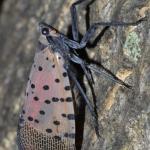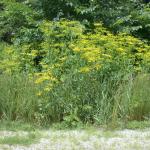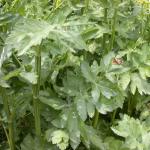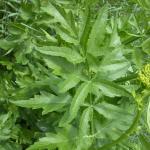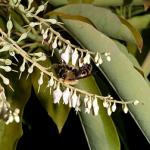A monthly e-newsletter from UMass Extension for landscapers, arborists, and other Green Industry professionals.
To read individual sections of the message, click on the section headings below to expand the content:
Hot Topics
Early-bird Green School rate extended to October 8!
UMass Extension's Green School is a comprehensive certificate short course for Green Industry professionals taught by UMass Extension specialists and University of Massachusetts faculty.
Location: Doubletree Hotel, Milford, MA
Dates: October 29 - December 13, 2018, twice weekly from 9:00 am to 3:30 pm
http://ag.umass.edu/landscape/education/umass-extensions-green-school
Designed for landscapers, lawn care specialists, nursery operators, sports field managers, public and private grounds managers, arborists and others in the green industry, our comprehensive course is for horticultural professionals who want to gain an understanding of economically feasible and environmentally responsible plant and land care practices and the relation of those practices to protecting the environment. Both experienced professionals as well as those entering the green industries will benefit from this course. Instruction is done via classroom style lecture and interactive activities, and is supplemented through online resources via an online learning management system.
THREE SPECIALTY TRACKS TO CHOOSE FROM
- Landscape Management
- Turf Management
- Arboriculture
For more details or a registration form, go to www.umasgreeninfo.org or call (413) 545-0895.
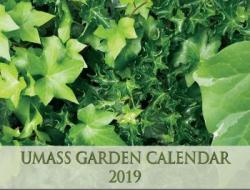 The 2019 UMass Extension Garden Calendar is Now Available!
The 2019 UMass Extension Garden Calendar is Now Available!
Gardening is enjoyed by so many people — it can ease stress, keep you limber, and even improve your mood! To help keep your plants healthy, productive, and beautiful, the 2019 UMass Garden Calendar offers helpful guidelines, daily tips, and an inspiring garden image each month!
For many years, UMass Extension has worked with the citizens of Massachusetts to help them make sound choices about growing, planting and maintaining plants in their landscapes, including vegetables, backyard fruits, and ornamental plants. Our 2019 calendar continues UMass Extension’s tradition of providing gardeners with useful information. This year’s calendar features the use of tomography to identify internal decay in mature trees that do not yet show any visible symptoms of damage, making it difficult to assess their potential risk in urban and suburban settings.
Each Month Features
- An inspiring garden image
- Daily gardening tips for Northeast growing conditions
- Daily sunrise and sunset times
- Phases of the moon
- Plenty of room for notes
- Low gloss paper for easy writing
Cost: $14 (a bulk rate is available for quanties of 10 or more)
ORDER ONLINE at www.umassgardencalendar.org
Questions & Answers
Q. What is the spotted lanternfly? What plants does it feed on?
A. The spotted lanternfly (Lycorma delicatula), also known as a lanternmoth, is neither a fly nor a moth. This insect is a member of the Order Hemiptera (true bugs, cicadas, hoppers, aphids, and others) and the Family Fulgoridae, also known as planthoppers. This insect is a non-native species first detected in the United States in Berks County, Pennsylvania and confirmed on September 22, 2014.
The spotted lanternfly is considered native to China, India, and Vietnam. It has been introduced as a non-native insect to South Korea and Japan prior to its detection in the United States. In South Korea, it is considered invasive and a pest of grapes and peaches. The insect uses piercing-sucking mouthparts to feed on plant fluids in both the nymphal and adult stages. They may be found feeding on most above-ground plant parts, including trunks, stems, branches, and leaves.
This insect has over 70 reported species of host plants, including:
Tree of heaven (Ailanthus altissima) (preferred host), apple (Malus spp.), plum, cherry, peach, apricot (Prunus spp.), grape (Vitis spp.), pine (Pinus spp.), pignut hickory (Carya glabra), sassafras (Sassafras albidum), serviceberry (Amelanchier spp.), slippery elm (Ulmus rubra), tulip poplar (Liriodendron tulipifera), white ash (Fraxinus americana), willow (ispp.), American beech (Fagus grandifolia), American linden (Tilia americana), American sycamore (Platanus occidentalis), big-toothed aspen (Populus grandidentata), black birch (Betula lenta), black cherry (Prunus serotina), black gum (Nyssa sylvatica), black walnut (Juglans nigra), dogwood (Cornus spp.), Japanese snowbell (Styrax japonicus), maple (Acer spp.), oak (Quercus spp.), and paper birch (Betula papyrifera).
Q. Has the spotted lanternfly been found in Massachusetts?
A. To date, the spotted lanternfly has NOT been found in Massachusetts. It has, however, been recently detected in additional locations outside of Pennsylvania.
Q. Where has the spotted lanternfly been found in the United States?
A. This insect was first detected in the United States in Berks County, Pennsylvania and confirmed on September 22, 2014. Since then, it has been detected in additional counties in PA. These locations can be seen at http://bit.ly/2lGJQzQ .
Unfortunately, the spotted lanternfly has also been detected in additional states. It has now been reported from Delaware (Nov. 20, 2017), New York (Nov. 29, 2017 and Sept. 11, 2018), Virginia (Jan. 10, 2018), and New Jersey (July 17, 2018). The most recent detections in New York were in Albany and Yates Counties on September 11, 2018. In Albany County, a single adult insect was found in a vehicle. In the case of Yates County, a single spotted lanternfly was confirmed on a private property. For more information, go to http://www.dec.ny.gov/press/114646.html .
Q. What does the spotted lanternfly look like? Where might I find it?
A. Adults are 1 inch long and one-half inch wide at rest. The forewing is gray with black spots of varying sizes, and the wing tips have black spots outlined in gray. The hind wings have contrasting patches of red and black with a white band. The legs and head are black, and the abdomen is yellow with black bands.
Early instars (immature stages; 1st, 2nd, and 3rd instar) are black with white spots. By the last immature stage, the 4th instar, they develop red patches in addition to the black color with white spots. Both the immature insect and the adult are quite visually striking. Adults are especially so when they have been startled and expose the bright red coloration on the hind wings.
When the adult is at rest, particularly on the trunk of the tree of heaven, their gray, spotted color may actually cause them to blend in with their surroundings. Freshly laid egg masses appear as if coated with a white substance. As they age, the egg masses look as if they are coated with gray mud, which eventually takes on a dry/cracked appearance. Very old egg masses may look like rows of 30-50 brown seed-like structures aligned vertically in columns. Coated egg masses may look like “weird” gypsy moth egg masses, but of course, they are very different insects and should not be confused.
The adults, nymphs, and egg masses of the spotted lanternfly may be found on any of the previously mentioned host plants. Egg masses may be laid on nearly any flat surface, including stone, bricks, fence posts, firewood, nursery stock, lawn furniture, recreational vehicles, etc. This insect is adept at hitchhiking in all life stages, but particularly as an adult and as an egg mass stuck to goods moved during trade.
Q. If I find a spotted lanternfly in Massachusetts, what should I do? Who should I report it to?
A. If you find any life stage (egg, nymph, or adult) of the spotted lanternfly (Lycorma delicatula) in Massachusetts, please report it immediately at https://massnrc.org/pests/report.aspx. You will be asked to provide your name and contact information, the location of the sighting (address and/or GPS coordinates) and a description of what you have found. If you can, capture a specimen (adult or nymph) and place it in a sealed container in the refrigerator or freezer. If you cannot capture an insect, take a clear, in-focus photo of the adult, nymph, or egg mass. Do not move any of the life stages of this insect other than to collect a specimen to submit for identification.
Q. Where can I find more information about the spotted lanternfly?
A. More information about the spotted lanternfly can be found in UMass Extension’s Spotted Lanternfly fact sheet at https://ag.umass.edu/landscape/fact-sheets/spotted-lanternfly .
Tawny Simisky, UMass Extension Entomologist
Trouble Maker of the Month
Beware of Wild Parsnip
Wild or field parsnip, Pastinaca sativa, is a member of the carrot family (Apiaceae). Wild parsnip is an herbaceous, biennial plant growing 2 to 5 feet tall with occasional branching. The stems are glabrous, angular and furrowed. The alternate leaves are oddly pinnate, consisting of about 9 leaflets that are mostly hairless. The lower compound leaves are up to 18" long and 6" across with long petioles. The upper compound leaves are smaller with short petioles. The individual leaflets are up to 3" long, 2" across, and ovate or elliptic in outline with cleft lobes and coarse teeth along the margins.
Health concerns
Health concerns arise when the sap of wild parsnip contacts your skin. Wild parsnip sap contains chemicals called psoralens (furocoumarins) that cause what dermatologists call "phyto-photo-dermatitis" - an inflammation (itis) of the skin (derm) induced by a plant (phyto) with the help of sunlight (photo). When absorbed by the skin, furocoumarins are energized by ultraviolet light from the sun, causing them to bind with nuclear DNA and cell membranes. This process destroys cells and skin tissue.
In mild cases, affected skin reddens and feels sunburned. In more severe cases, the skin becomes red, followed by blisters and for a period of time when the area will feels as if it has been scalded. Often visible and permanent scaring occurs after the blisters heal. Areas of the body where skin is most sensitive (arms, legs, torso, face, neck) are most vulnerable. Moisture from perspiration speeds the absorption of the psoralens. Wild parsnip is known to occur in all counties of Massachusetts but, from my observations, this species is more prevalent in the five western counties of the state.
Management (strategy will be determined by growing site)
Mowing: Wild parsnip should be mowed at the initiation of flowering, which typically occurs in July. Growing season variability and site conditions will impact the timing of flowering. Repeated mowing will prevent seed production and over time will exhaust the weed seed bank. If possible, a dedicated mower should be used when mowing wild parsnip. A dedicated mower will prevent the spread of wild parsnip to other locations and protect staff from inadvertently being exposed to wild parsnip sap should equipment maintenance be required.
Smothering: Small populations of wild parsnip can be smothered with landscape or nursery fabric, tarps, rubber mats, and other similar materials.
Physical removal: Very small populations or first introduction plants can be dug and uprooted. Plants removed that are free of seed can be left to thoroughly dry and then composted. Personal protective equipment should be worn throughout the process.
Herbicides: The use of a translocated herbicide (ex. glyphosate) can be used to control wild parsnip. Broadleaf herbicides such as triclopyr, 2,4-D and dicamba can be used so as not to kill desirable grasses. Leaving grasses and encouraging their growth will compete with newly establishing wild parsnip. Non-chemical products containing clove oil, citric acid, acetic acid or orange extract can be used in lieu of herbicides. These materials are contact in nature, killing only the portions of the plant on which they are applied, and will required repeated applications during the growing season. The first application of these materials should be made at the first sign of wild parsnip green-up in early spring and be reapplied as new growth is observed.
Randy Prostak, UMass Extension Weed Specialist
Plant of the Month
Oxydendrum arboreum, Sourwood
Sourwood, Oxydendrum arboretum, is a wonderful small tree with multi season interest. Sourwood has great fall foliage with colors ranging from yellow to red and purple, often with all three colors at the same time. Sourwood also has delightful summer flowers - hanging racemes of white flowers a little reminiscent of lily of the valley. The flowers give way to persistent fruit capsules that remain on the tree into winter. The foliage is an attractive glossy green and similar in appearance to peach leaves.
Sourwood is a North American native commonly seen in the Southern Appalachians and hardy in USDA zones 5-9. The tree grows approximately 25-30 feet tall with a spread of about 20 feet; in the wild it can reach heights of 60 feet. The tree is slow growing with a pyramidal to rounded habit. Sourwood grows best in slightly acidic, well drained soils with medium moisture. Sourwood is intolerant of compacted soil, excessively drained soil, or root disturbance and therefore not a great option in urban settings. Younger transplants of balled and burlaped or container grown plants are better than older, larger specimens.
The genus name, oxys (acid) and dendron (tree), as well as the common name sourwood give reference to the bitter or sour taste of the leaves. Conversely, the flowers are highly attractive to bees and sourwood honey is highly prized. The small tree makes a great residential specimen or used in the border with other Ericaceae plants such as Leucothoe, Pieris, Rhododendron, or Vaccinium.
Russ Norton, Agriculture & Horticulture Extension Educator, Cape Cod Cooperative Extension
Upcoming Events
SAVE THE DATE! 2018 Fall Wrap-Up
November 27, 2018 - 8:30 am to 4:00 pm
Location: Hadley Farms Meeting House, Hadley MA
Join our UMass Extension Specialists for a look at the challenges and problems of the 2018 season. Topics include woody plant insects and diseases, landscape weeds, how to deal with weedy grass failures – factors that may contribute to poor control and/or summer surge, turf insects, how to distinguish whether decline or damage to turf is due to pests or abiotic stressors, and BMPs to maximize turf stress tolerance. Pesticide contact hours and association credits pending.
Oct 8 - Early-bird registration rate ends for Green School
UMass Extension's Green School is our bi-annual certificate course, scheduled for this fall in Milford, MA. Green School meets twice per week starting October 29 and runs through December 13, 2018. Three educational tracks are offered: Landscape Management, Turf Management, and Arboriculture. Green School will not be offered again until fall 2020.
For eligible employers, the Green School registration fee may be partially reimbursed through the Massachusetts Workforce Training Fund Express Grant Program. Employers need to submit an online application to the Express Grant program at least 6 weeks in advance of UMass Green School's starting date. To find out if you qualify and to apply for benefits, go to workforcetrainingfund.org/programs/express-program
For complete information about Green School, including the schedule, curriculum, and registration information, go to ag.umass.edu/landscape/education/umass-extensions-green-school
Other Upcoming Events:t
- 9/24: End of early-bird registration rate for Green School
- 10/22 Last day to register for Green School
- 10/29: First day of Green School
- 11/27 Fall Wrap-up - Hadley, MA
For more information and registration for any of these events, go to the UMass Extension Landscape, Nursery, and Urban Forestry Program Upcoming Events Page.
Additional Resources
For detailed reports on growing conditions and pest activity – Check out the Landscape Message
For commercial growers of greenhouse crops and flowers - Check out the New England Greenhouse Update website
For professional turf managers - Check out Turf Management Updates
For home gardeners and garden retailers - Check out home lawn and garden resources. UMass Extension also has a Twitter feed that provides timely, daily gardening tips, sunrise and sunset times to home gardeners, see https://twitter.com/UMassGardenClip
Diagnostic Services
A UMass Laboratory Diagnoses Landscape and Turf Problems - The UMass Extension Plant Diagnostic Lab is available to serve commercial landscape contractors, turf managers, arborists, nurseries and other green industry professionals. It provides woody plant and turf disease analysis, woody plant and turf insect identification, turfgrass identification, weed identification, and offers a report of pest management strategies that are research based, economically sound and environmentally appropriate for the situation. Accurate diagnosis for a turf or landscape problem can often eliminate or reduce the need for pesticide use. For sampling procedures, detailed submission instructions and a list of fees, see Plant Diagnostics Laboratory
Soil and Plant Nutrient Testing - The University of Massachusetts Soil and Plant Nutrient Testing Laboratory is located on the campus of The University of Massachusetts at Amherst. Testing services are available to all. The function of the Soil and Plant Nutrient Testing Laboratory is to provide test results and recommendations that lead to the wise and economical use of soils and soil amendments. For complete information, visit the UMass Soil and Plant Nutrient Testing Laboratory web site. Alternatively, call the lab at (413) 545-2311.
